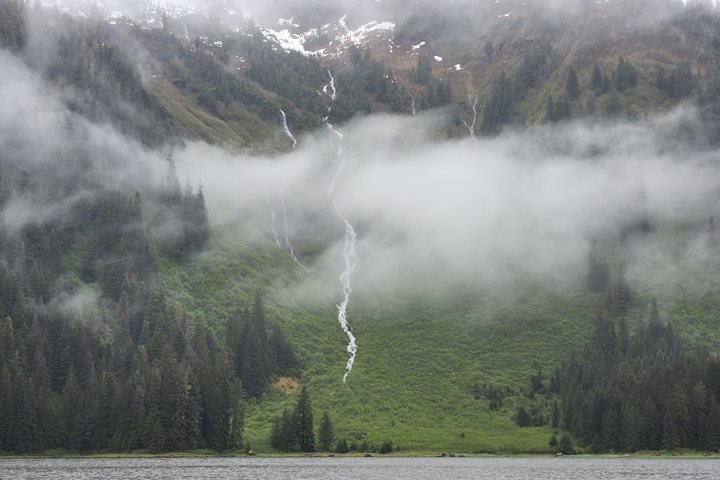Glacier Bay has so many stories to tell. Native Tlingit people used to live within view of the glacier, until it suddenly surged forward and forced them to leave. The glacier advanced and deep ice filled the bay and covered all of the land except for the high mountain peaks. From 1780 until the early 1900s, the ice receded in the fastest glacial retreat ever recorded. Life returned to Glacier Bay—plants and animals gradually re-colonized the land, and marine life returned to the waters.
Today we are exploring this wild and fresh land. As we travel up the bay, closer to remaining glaciers, the rocks are nearly bare of plants. The water near glaciers is light gray-green, from finely ground up rock, or ‘glacial flour.’
Joining us today is Glacier Bay National Park Ranger Chelsea Leven. Alice Haldane, a Tlingit woman from the town of Hoonah, is telling us stories of her people, teaching us some Tlingit words, and helping us understand the deep importance of Glacier Bay—the sacred homeland of her people.
Our first wildlife sightings today were at South Marble Island, an important seabird nesting island. Kittiwakes perched on nests built on the rock cliff. Common murres, colored black and white like penguins, stood on narrow ledges on the cliff face. This is nesting season, so the small island is crowded with birds. Tufted puffins with bright orange bills bobbed on the water, and flapped their wings quickly when flying. Numerous Steller sea lions rested on the rock ledges, and a sea otter floated near the ship.
The ship cruised up bay, and we paused at Gloomy Knob, which was shrouded in mist. Several mountain goat nannies and kids were visible halfway up the steep rock face. A short distance beyond them we sighted a brown bear walking down near the water.
At the head of Tarr Inlet, Margerie glacier was gorgeous, and the blue color of the dense ice was very pronounced. We sipped warm chai tea delivered to us on the ship’s bow, and listened to the glacier’s thunderous noises. Grand Pacific glacier is two miles across, yet it carries so much rock that it hardly looks like ice. Before departing the inlet, we watched four brown bears. One of them stood up on its hind legs a couple of times.
The sun poked through overcast skies, lending dramatic lighting on rocky mountainsides. We stopped to look at Lamplugh glacier, and the top of Mt. Cooper peeked down from nearly 7,000 feet above.
At Recap our young guests told us about the humpback whale skeleton that was assembled and put on display at Glacier Bay’s Visitor Center three weeks ago. The young people demonstrated the actual size of the whale in the ship’s lounge, and it was truly impressive. When we docked at Bartlett Cove after dinner, we saw the whale skeleton, and walked in a forest where a vast glacier once stood.







